Back around the turn of the millennium, tournament Magic jargon was a baroque slanguage of self-referential in-jokes and abbreviations—sentences abounded along the lines of “his barns all started celebrating when he mised an Opposition, but my tings still got there.” Seriously.
Reading tournament reports from the era now, it feels like a bit, like a joke to intentionally frustrate the reader. In the cold light of 2021, referring to Ravenous Baloth as “stone nuts” is corny and mortifying. Of course, in the colder light of 2040, I have no doubt that referring to Gideon Blackblade as a “based chad” will be just as embarrassing. Magic culture has always been insular to the point of sterility; its shibboleths are especially opaque to signal the in-group, emerging from and mutating on message boards and IRC chats.

Of all of the terms once in common usage, my favorite was always “DI”—standing for “der infinite” or “der infy,” most often used as either the “DI” initialism or just “infy.” The formality of the German “der” with the deep silliness of abbreviating “infinite” to the childish “infy” is playful and undercuts the awesome sincerity of “infinite.” It has a 1999 techno vibe to it—a period of time when the culture were too preoccupied with the end of history and club drugs and The Matrix to say the whole words.
“DI” either meant something conclusive—“I beat for six and then hit him with Consume Spirit for DI”—or something approximating the infinite. It was most often used hyperbolically—not to represent true infinite, but simply “a lot” to the point of domination: “Played Warchief, swung with the men and Piledriver for, I don’t know, DI.”
“DI” is a concept that has hung on past the era of “gassy” and “hulls” and “stains.” Magic etymology is a murky field—memes and terms propagated through various forums and the pages of The Dojo and Brainburst—and so it’s hard to pin down who originally coined “der infinite” or “der infy.” Ted Knutson defined it on the Wizards website in 2006, but it had been around at least since 2002. Geordie Tait used it in his articles frequently circa Onslaught, but I couldn’t find a patient zero for this particular piece of memetic slang. Perhaps it came from nowhere, born at the exact right time to spread through the Magic community. Maybe it was born fully formed out of the void of der infinite.
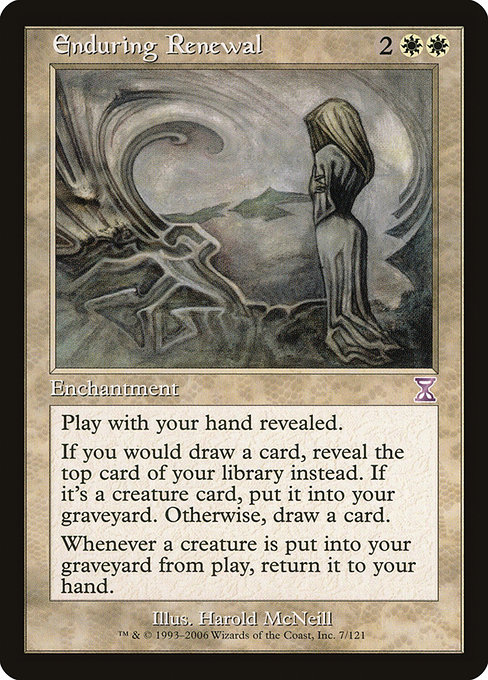
Infinity hasn’t been a part of Magic since the beginning—earlier combos were more dedicated to dealing 20 as quickly as possible via Channel–Fireball or a double-Berserked Craw Wurm. One of the earliest infinite combo decks was Fruity Pebbles, a deck that played Goblin Bombardment, Enduring Renewal, and any zero-cost creature (usually Ornithopter or Shield Sphere, which could block until you set up your combo). Those three cards in conjunction can do DI damage, but usually only went to 20.
For the record, with the printing of Goblin Bombardment in Modern Horizons 2, Fruity Pebbles is now Modern legal for the first time. A lot of players have forgotten that Enduring Renewal was reprinted in Time Spiral. If you’re looking to go infinite in the fashion of the very first combo decks, you can easily do so with Memnite or Walking Ballista. This seems fragile in a world with Leyline of the Void, Ravenous Trap, Nihil Spellbomb, etc., but I’m the last person to stop you.
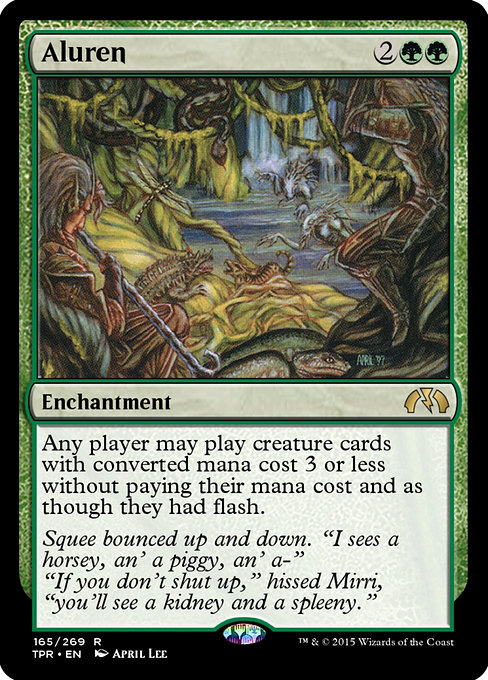
Planeshift brought Cavern Harpy into the fold, which gains infinite life with Aluren and Auriok Champion. We had a whole roster of combo decks with breakfast-themed names: Trix, which originated the trend, Cephalid Breakfast, which targeted Cephalid Illusionist repeatedly to mill the pilot’s deck, Cheerios, which uses zero-drop artifacts, etc.
Two-card combos, like Donate plus Illusions of Grandeur, didn’t die out as combo decks got more baroque in the mode of Cephalid Breakfast. Ravnica’s Flame Fusillade, at the time of printing, went infinite with Time Vault (this combo was very quickly errata’ed out of existence). Niv-Mizzet, the Firemind plus Curiosity was expensive and fragile, but effective. Shadowmoor Block had Devoted Druid and Quillspike. Zendikar’s Splinter Twin created an arbitrarily large number of copies of Deceiver Exarch or Pestermite, and so on.
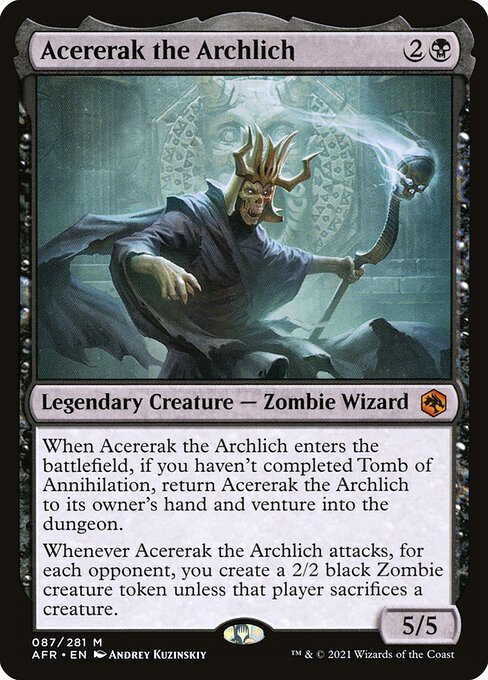
While the limitations of Arena and modern design rules have kept infinite combos out of contention of late, Wizards did (accidentally?) print a new Aluren enabler in Adventures in the Forgotten Realms. Acererak the Archlich plus Aluren means DI drain: simply choose not to venture into the Tomb of Annihilation, and you’ll be able to bounce and replay Acererak to venture into the Lost Mine of Phandelver for a life and a card each time you run the dungeon.
The loop is limited by the number of cards in your deck, but Laboratory Maniac or Thassa’s Oracle can ensure your win, if your opponent somehow has more life than you have cards. You can also, of course, shut the loop off by completing Tomb of Annihilation at any point in the loop. In Modern, you can pull this combo off with Rooftop Storm in place of Aluren, but landing a six-mana enchantment is a big ask.
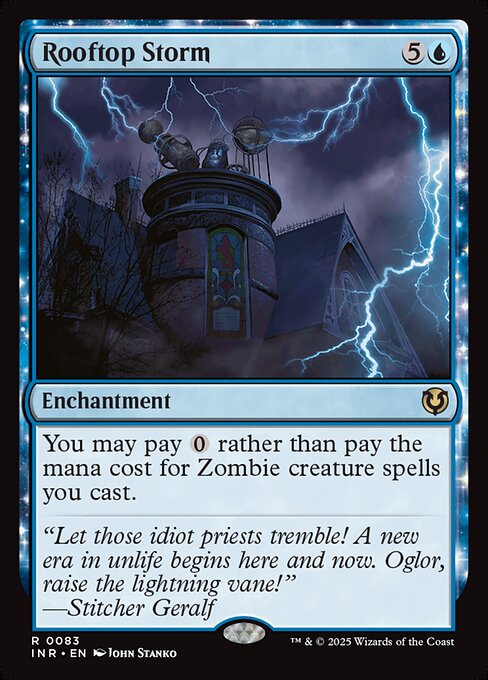
I find the Acererak combo deeply amusing, as it underlines that “infinite” has no real meaning in Magic, or, more accurately, has several meanings. Tournament rules state that any combo that can create an infinite loop has to be bounded by a large number chosen by the combo player. “Arbitrarily large” is the Magic shorthand for “infinite,” and combo players have their standard huge numbers to repeat a loop for: a googolplex, a million and one, etc. Even now, twenty-odd years later, it’s still der infy.
Acererak may have been an accident (or may have been perceived as low-impact enough to release as-is), but the recent reveal of Champion of the Perished suggests a new trend for Zombie combo. Any time I see a new, cheap Zombie, I immediately inquire “how does this interact with Gravecrawler?” As it turns out, Gravecrawler plus Phyrexian Altar plus the Champion is an arbitrarily large/arbitrarily large Champion attacking as early as turn three, assuming a perfect draw. In Modern, Carrion Feeder stands in for the Altar, allowing you to give Champion and Carrion Feeder +1/+1 counters for each black mana you spend—not DI or arbitrarily large, but pretty efficient nonetheless.
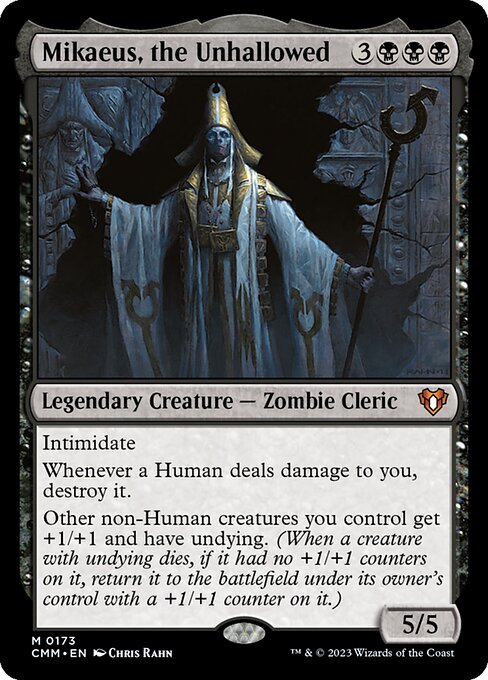
As someone who plays Undying Yawgmoth combo in Modern and has dabbled with Goblin combo in Historic, I’m drawn to creature-based “infinite” combos. Yawgmoth combo is resilient, flexible, and challenging, while Allurenrak is a two-card “I win” button unless your opponent has Stifle or similar interactive card. Many Competitive EDH decks and casual Commander decks have similar combos, from the 2012-era Mikaeus the Unhallowed plus Triskelion combo to Niv-Mizzet plus Ophidian Eye to various Protean Hulk combos.
I think a lot about whether infinity can intersect with cordial, noncompetitive Commander games—some folks consider infinite combos a breach of etiquette, while others see them as a valid way to close out a game, and others default to a combo in almost all their decks. Personally, I’d rather win through a barrage of counterplay and removal with an infinite combo than attack for 40 three times, and I don’t see much of a difference between Altar of the Brood+Felidar Guardian+Phyrexian Metamorph versus Triumph of the Hordes with a horde of beaters.

What I find most appealing about Commander combo, though, is the arrogance and etiquette of an unlimited combo that you artificially limit yourself. Anyone can slap an Aluren and an Acererak on the table and claim victory, but running through the Lost Mine five times and then choosing to complete the Tomb of Annihilation and continue the game as before your “combo” is both magnanimous and deeply smug. Smuganimous, if you will.
I’ve been working on a Green/Black Commander deck that hits der infy as much as possible—a deck that includes combos from the last ten years of Commander development, like a living document of groan-inducing plays and an evolving roster of “wait, walk me through that” interactions. One thing I believe established Commander players forget is that combos you’ve never seen before is, to a lot of newer players, cool. I don’t break this deck out with people who know the intricacies of the format, but it’s an absolutely hilarious deck to break out with less-jaded players.
Richard Garfield seems to have learned from the ease of combo finishes in Magic. His game Keyforge, for example, caps combos by only letting you play the same card a maximum of six times in one turn—something the game terms “The Rule of Six.”
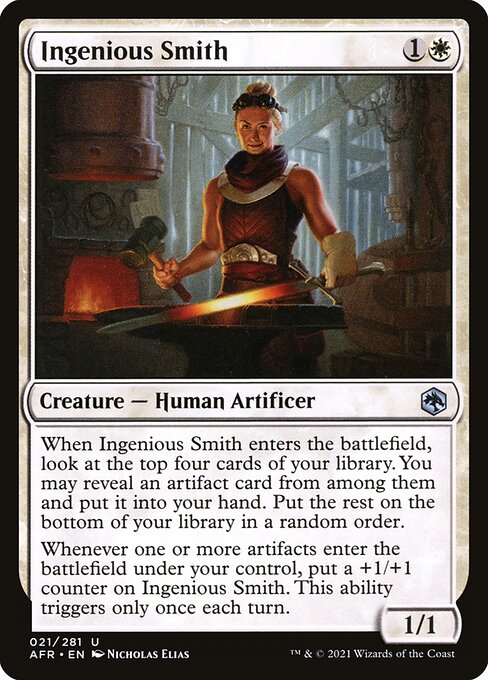
Even Wizards seems dedicated to limiting combos these days—take a look at Elvish Warmaster,Ingenious Smith, Mavinda, Students’ Advocate, or Varis, Silverymoon Ranger. These are gated to occur once a turn, rather than the unbounded wording of earlier cards. While this is a good safety valve to prevent unintended combos with later-printed cards—and helps streamline Arena/Magic Online—it does mean we have to work harder for our combos in Standard and Pioneer. We’re moving away from the infinite.
The thing about infinity is that it inspires awe: to consider the infinite is to erase yourself, to humble yourself before an unending, unlimited scale. We may attempt to characterize it with the silly “der infy,” but that diminutive only proves how threatening the infinite really is. Flipping Kiki-Jikis and Splinter Twins may be the most inconsequential way to represent the infinite, but it still reminds us that, with the combination of two scraps of cardboard, we can match all the atoms in the universe, all the stars in the endless cosmos, all the Splinter Twinned Deceiver Exarchs that have or ever could be printed.
A lifelong resident of the Carolinas and a graduate of the University of North Carolina, Rob has played Magic since he picked a Darkling Stalker up off the soccer field at summer camp. He works for nonprofits as an educational strategies developer and, in his off-hours, enjoys writing fiction, playing games, and exploring new beers.

